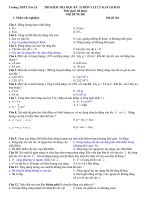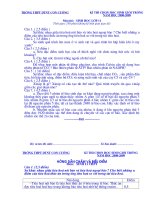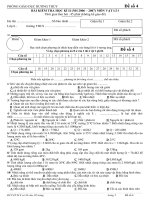Đề thi và đáp án CMO năm 2004
Bạn đang xem bản rút gọn của tài liệu. Xem và tải ngay bản đầy đủ của tài liệu tại đây (51.54 KB, 6 trang )
<span class='text_page_counter'>(1)</span><div class='page_container' data-page=1>
<b>Solutions to the 2004 CMO</b>
written March 31, 2004
1. Find all ordered triples (x, y, z) of real numbers which satisfy the following system of
equations: <sub></sub>
<i>xy</i> = <i>z</i>−<i>x</i>−<i>y</i>
<i>xz</i> = <i>y</i>−<i>x</i>−<i>z</i>
<i>yz</i> = <i>x</i>−<i>y</i>−<i>z</i>
<b>Solution 1</b>
Subtracting the second equation from the first gives<i>xy</i>−<i>xz</i>= 2z−2y. Factoring<i>y</i>−<i>z</i>
from each side and rearranging gives
(x+ 2)(y−<i>z) = 0,</i>
so either<i>x</i>=−2 or <i>z</i> =<i>y.</i>
If <i>x</i> = −2, the first equation becomes −2y = <i>z</i>+ 2−<i>y, or</i> <i>y</i>+<i>z</i> =−2. Substituting
<i>x</i>=−2, <i>y</i>+<i>z</i> =−2 into the third equation gives<i>yz</i> =−2−(−2) = 0. Hence either<i>y</i>
or <i>z</i> is 0, so if <i>x</i>=−2, the only solutions are (−2,0,−2) and (−2,−2,0).
If <i>z</i> = <i>y</i> the first equation becomes <i>xy</i> = −<i>x, or</i> <i>x(y</i>+ 1) = 0. If <i>x</i> = 0 and <i>z</i> = <i>y,</i>
the third equation becomes <i>y</i>2 = −2y which gives <i>y</i> = 0 or <i>y</i> = −2. If <i>y</i> = −1 and
<i>z</i> = <i>y</i> = −1, the third equation gives <i>x</i> = −1. So if <i>y</i> = <i>z, the only solutions are</i>
(0,0,0), (0,−2,−2) and (−1,−1,−1).
In summary, there are 5 solutions: (−2,0,−2), (−2,−2,0), (0,0,0), (0,−2,−2) and
(−1,−1,−1).
<b>Solution 2</b>
Adding <i>x</i> to both sides of the first equation gives
<i>x(y</i>+ 1) =<i>z</i>−<i>y</i>= (z+ 1)−(y+ 1) ⇒ (x+ 1)(y+ 1) =<i>z</i>+ 1.
Similarly manipulating the other two equations and letting <i>a</i> = <i>x</i>+ 1, <i>b</i> = <i>y</i>+ 1,
<i>c</i>=<i>z</i>+ 1, we can write the system in the following way.
<i>ab</i> = <i>c</i>
<i>ac</i> = <i>b</i>
<i>bc</i> = <i>a</i>
</div>
<span class='text_page_counter'>(2)</span><div class='page_container' data-page=2>
2. How many ways can 8 mutually non-attacking rooks be placed
on the 9×9 chessboard (shown here) so that all 8 rooks are on
squares of the same colour?
[Two rooks are said to be attacking each other if they are placed
in the same row or column of the board.]
<b>Solution 1</b>
We will first count the number of ways of placing 8 mutually non-attacking rooks on
black squares and then count the number of ways of placing them on white squares.
Suppose that the rows of the board have been numbered 1 to 9 from top to bottom.
First notice that a rook placed on a black square in an odd
numbered row cannot attack a rook on a black square in an even
numbered row. This effectively partitions the black squares into
a 5×5 board and a 4 ×4 board (squares labelled <i>O</i> and <i>E</i>
respectively, in the diagram at right) and rooks can be placed
independently on these two boards. There are 5! ways to place
5 non-attacking rooks on the squares labelled<i>O</i> and 4! ways to
place 4 non-attacking rooks on the squares labelled<i>E.</i>
<b>O</b> <b>O</b> <b>O</b> <b>O</b> <b>O</b>
<b>O</b> <b>O</b> <b>O</b> <b>O</b> <b>O</b>
<b>O</b> <b>O</b> <b>O</b> <b>O</b> <b>O</b>
<b>O</b> <b>O</b> <b>O</b> <b>O</b> <b>O</b>
<b>O</b> <b>O</b> <b>O</b> <b>O</b> <b>O</b>
<b>E</b> <b>E</b> <b>E</b> <b>E</b>
<b>E</b> <b>E</b> <b>E</b> <b>E</b>
<b>E</b> <b>E</b> <b>E</b> <b>E</b>
<b>E</b> <b>E</b> <b>E</b> <b>E</b>
This gives 5!4! ways to place 9 mutually non-attacking rooks on black squares and
removing any one of these 9 rooks gives one of the desired configurations. Thus there
are 9·5!4! ways to place 8 mutually non-attacking rooks on black squares.
Using very similar reasoning we can partition the white squares
as shown in the diagram at right. The white squares are
par-titioned into two 5 ×4 boards such that no rook on a square
marked <i>O</i> can attack a rook on a square mark <i>E. At most 4</i>
non-attacking rooks can be placed on a 5×4 board and they
can be placed in 5·4·3·2 = 5! ways. Thus there are (5!)2 <sub>ways</sub>
to place 8 mutually non-attacking rooks on white squares. O O O O
O O O O
O O O O
O O O O
O O O O
E E E E E
E E E E E
E E E E E
E E E E E
</div>
<span class='text_page_counter'>(3)</span><div class='page_container' data-page=3>
<b>Solution 2</b>
Consider rooks on black squares first. We have 8 rooks and 9 rows, so exactly one row
will be without rooks. There are two cases: either the empty row has 5 black squares
or it has 4 black squares. By permutation these rows can be made either last or second
last. In each case we’ll count the possible number of ways of placing the rooks on the
board as we proceed row by row.
In the first case we have 5 choices for the empty row, then we can place a rook on any
of the black squares in row 1 (5 possibilities) and any of the black squares in row 2 (4
possibilities). When we attempt to place a rook in row 3, we must avoid the column
containing the rook that was placed in row 1, so we have 4 possibilities. Using similar
reasoning, we can place the rook on any of 3 possible black squares in row 4, etc. The
total number of possibilities for the first case is 5·5·4·4·3·3·2·2·1 = (5!)2. In the
second case, we have 4 choices for the empty row (but assume it’s the second last row).
We now place rooks as before and using similar logic, we get that the total number of
possibilities for the second case is 4·5·4·4·3·3·2·1·1 = 4(5!4!).
Now, do the same for the white squares. If a row with 4 white squares is empty (5
ways to choose it), then the total number of possibilities is (5!)2. It’s impossible to
have a row with 5 white squares empty, so the total number of ways to place rooks is
</div>
<span class='text_page_counter'>(4)</span><div class='page_container' data-page=4>
3. Let<i>A, B, C, D</i>be four points on a circle (occurring in clockwise order), with<i>AB < AD</i>
and <i>BC > CD. Let the bisector of angle</i> <i>BAD</i> meet the circle at <i>X</i> and the bisector
of angle <i>BCD</i> meet the circle at <i>Y</i>. Consider the hexagon formed by these six points
on the circle. If four of the six sides of the hexagon have equal length, prove thatBD
must be a diameter of the circle.
<i>A</i>
<i>B</i>
<i>C</i>
<i>D</i>
<i>X</i>
<i>Y</i>
α
α γ
γ
<b>Solution 1</b>
We’re given that <i>AB < AD</i>. Since<i>CY</i> bisects ]<i>BCD</i>, <i>BY</i> =<i>Y D</i>, so<i>Y</i> lies between
<i>D</i> and <i>A</i> on the circle, as in the diagram above, and <i>DY > Y A</i>, <i>DY > AB</i>. Similar
reasoning confirms that <i>X</i> lies between <i>B</i> and <i>C</i> and <i>BX > XC</i>, <i>BX > CD</i>. So if
<i>ABXCDY</i> has 4 equal sides, then it must be that <i>Y A</i> =<i>AB</i> =<i>XC</i> =<i>CD</i>.
Let ]<i>BAX</i> = ]<i>DAX</i> = <i>α</i> and let ]<i>BCY</i> = ]<i>DCY</i> = <i>γ</i>. Since <i>ABCD</i> is cyclic,
]<i>A</i>+]<i>C</i> = 180◦, which implies that<i>α</i>+<i>γ</i> = 90◦. The fact that<i>Y A</i>=<i>AB</i> =<i>XC</i> =<i>CD</i>
means that the arc from<i>Y</i> to<i>B</i> (which is subtended by]<i>Y CB</i>) is equal to the arc from
<i>X</i> to <i>D</i> (which is subtended by ]<i>XAD</i>). Hence ]<i>Y CB</i> =]<i>XAD</i>, so <i>α</i> =<i>γ</i> = 45◦<sub>.</sub>
Finally, <i>BD</i> is subtended by ]<i>BAD</i> = 2<i>α</i> = 90◦. Therefore <i>BD</i> is a diameter of the
circle.
<b>Solution 2</b>
We’re given that <i>AB < AD</i>. Since<i>CY</i> bisects ]<i>BCD</i>, <i>BY</i> =<i>Y D</i>, so<i>Y</i> lies between
<i>D</i> and <i>A</i> on the circle, as in the diagram above, and <i>DY > Y A</i>, <i>DY > AB</i>. Similar
reasoning confirms that <i>X</i> lies between <i>B</i> and <i>C</i> and <i>BX > XC</i>, <i>BX > CD</i>. So
if <i>ABXCDY</i> has 4 equal sides, then it must be that <i>Y A</i> = <i>AB</i> = <i>XC</i> = <i>CD</i>.
This implies that the arc from <i>Y</i> to <i>B</i> is equal to the arc from <i>X</i> to <i>D</i> and hence
that <i>Y B</i> = <i>XD</i>. Since ]<i>BAX</i> = ]<i>XAD</i>, <i>BX</i> = <i>XD</i> and since ]<i>DCY</i> = ]<i>Y CB</i>,
</div>
<span class='text_page_counter'>(5)</span><div class='page_container' data-page=5>
4. Let<i>p</i> be an odd prime. Prove that
p−1
X
k=1
<i>k</i>2p−1≡ <i>p(p</i>+ 1)
2 (mod <i>p</i>
2
).
[Note that <i>a</i>≡<i>b</i> (mod <i>m) means that</i> <i>a</i>−<i>b</i>is divisible by <i>m.]</i>
<b>Solution</b>
Since <i>p</i>−1 is even, we can pair up the terms in the summation in the following way
(first term with last, 2nd term with 2nd last, etc.):
p−1
X
k=1
<i>k</i>2p−1 =
p−1
2
X
k=1
<i>k</i>2p−1+ (p−<i>k)</i>2p−1<i>.</i>
Expanding (p−<i>k)</i>2p−1 <sub>with the binomial theorem, we get</sub>
(p−<i>k)</i>2p−1 =<i>p</i>2p−1− · · · −
2p−1
2
<i>p</i>2<i>k</i>2p−3+
2p−1
1
<i>pk</i>2p−2−<i>k</i>2p−1<i>,</i>
where every term on the right-hand side is divisible by<i>p</i>2 except the last two. Therefore
<i>k</i>2p−1+ (p−<i>k)</i>2p−1 ≡<i>k</i>2p−1+
2p−1
1
<i>pk</i>2p−2−<i>k</i>2p−1 ≡(2p−1)pk2p−2 (mod <i>p</i>2).
For 1≤ <i>k < p,k</i>is not divisible by<i>p, sok</i>p−1 <sub>≡</sub><sub>1 (mod</sub> <i><sub>p), by Fermat’s Little Theorem.</sub></i>
So (2p−1)k2p−2 <sub>≡</sub> <sub>(2p</sub><sub>−</sub><sub>1)(1</sub>2<sub>)</sub><sub>≡ −</sub><sub>1 (mod</sub> <i><sub>p), say (2p</sub></i><sub>−</sub><sub>1)k</sub>2p−2 <sub>=</sub> <i><sub>mp</sub></i><sub>−</sub><sub>1 for some</sub>
integer<i>m. Then</i>
(2p−1)pk2p−2 =<i>mp</i>2−<i>p</i>≡ −<i>p</i> (mod <i>p</i>2).
Finally,
p−1
X
k=1
<i>k</i>2p−1 ≡
p−1
2
X
k=1
(−<i>p)</i>≡
<i>p</i>−1
2
(−<i>p) (mod</i> <i>p</i>2)
≡ <i>p</i>−<i>p</i>
2
2 +<i>p</i>
2
≡ <i>p(p</i>+ 1)
2 (mod <i>p</i>
2
</div>
<span class='text_page_counter'>(6)</span><div class='page_container' data-page=6>
5. Let<i>T</i> be the set of all positive integer divisors of 2004100. What is the largest possible
number of elements that a subset <i>S</i> of <i>T</i> can have if no element of <i>S</i> is an integer
multiple of any other element of <i>S?</i>
<b>Solution</b>
Assume throughout that <i>a, b, c</i>are nonnegative integers. Since the prime factorization
of 2004 is 2004 = 22·3·167,
<i>T</i> =n2a3b167c<sub></sub>0≤<i>a</i>≤200, 0≤<i>b, c</i>≤100o<i>.</i>
Let
<i>S</i> =
n
2200−b−c3b167c
0≤<i>b, c</i>≤100
o
<i>.</i>
For any 0≤<i>b, c</i>≤100, we have 0≤200−<i>b</i>−<i>c</i>≤200, so<i>S</i> is a subset of<i>T</i>. Since there
are 101 possible values for <i>b</i> and 101 possible values for <i>c,</i> <i>S</i> contains 1012 <sub>elements.</sub>
We will show that no element of <i>S</i> is a multiple of another and that no larger subset
of <i>T</i> satisfies this condition.
Suppose 2200−b−c<sub>3</sub>b<sub>167</sub>c <sub>is an integer multiple of 2</sub>200−j−k<sub>3</sub>j<sub>167</sub>k<sub>. Then</sub>
200−<i>b</i>−<i>c</i>≥200−<i>j</i>−<i>k,</i> <i>b</i>≥<i>j,</i> <i>c</i>≥<i>k.</i>
But this first inequality implies <i>b</i>+<i>c</i>≤ <i>j</i>+<i>k, which together with</i> <i>b</i>≥<i>j</i>, <i>c</i>≥<i>k</i> gives
<i>b</i>=<i>j</i> and<i>c</i>=<i>k. Hence no element of</i> <i>S</i> is an integer multiple of another element of<i>S.</i>
Let<i>U</i> be a subset of<i>T</i> with more than 1012 <sub>elements. Since there are only 101</sub>2 <sub>distinct</sub>
pairs (b, c) with 0≤<i>b, c</i>≤100, then (by the pigeonhole principle)<i>U</i> must contain two
elements<i>u1</i> = 2a1<sub>3</sub>b1<sub>167</sub>c1 <sub>and</sub> <i><sub>u2</sub></i> <sub>= 2</sub>a2<sub>3</sub>b2<sub>167</sub>c2<sub>, with</sub> <i><sub>b1</sub></i> <sub>=</sub><i><sub>b2</sub></i> <sub>and</sub> <i><sub>c1</sub></i> <sub>=</sub><i><sub>c2, but</sub></i> <i><sub>a1</sub></i> <sub>6</sub><sub>=</sub><i><sub>a2.</sub></i>
If<i>a1</i> <i>> a2, thenu1</i> is a multiple of <i>u2</i> and if<i>a1</i> <i>< a2</i>, then<i>u2</i> is a multiple of<i>u1. Hence</i>
<i>U</i> does not satisfy the desired condition.
</div>
<!--links-->









